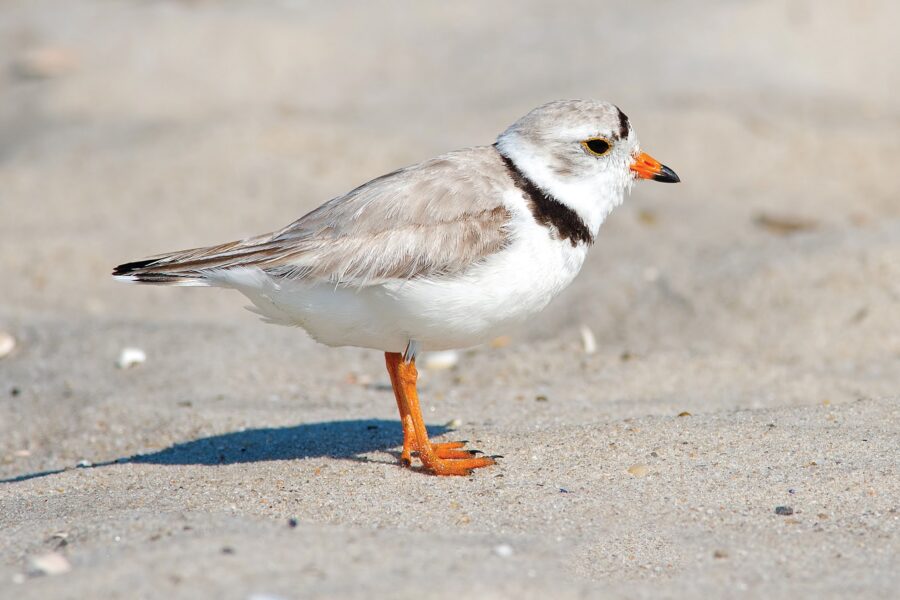Ecosystem Targets and Supporting Indicators
Piping Plovers
Piping plovers are small shorebirds that nest on the beaches of Long Island Sound. The abundance of breeding pairs reflects availability of beach nesting habitat and management efforts to protect nesting pairs from human intrusion, storm tides and predators.
View Implementation Actions for Piping Plovers| Piping Plovers (Nesting Pairs) | |||
|---|---|---|---|
| NY | CT | Total | |
| 1990 | - | 43 | - |
| 1991 | - | 36 | - |
| 1992 | - | 40 | - |
| 1993 | - | 24 | - |
| 1994 | - | 30 | - |
| 1995 | - | 31 | - |
| 1996 | - | 26 | - |
| 1997 | - | 26 | - |
| 1998 | - | 21 | - |
| 1999 | - | 22 | - |
| 2000 | 61 | 22 | 83 |
| 2001 | 69 | 32 | 101 |
| 2002 | 91 | 31 | 122 |
| 2003 | 83 | 37 | 120 |
| 2004 | 85 | 40 | 125 |
| 2005 | 69 | 34 | 103 |
| 2006 | 92 | 37 | 129 |
| 2007 | 92 | 36 | 128 |
| 2008 | 94 | 41 | 135 |
| 2009 | 89 | 44 | 133 |
| 2010 | 84 | 43 | 127 |
| 2011 | 73 | 52 | 125 |
| 2012 | 72 | 51 | 123 |
| 2013 | 60 | 45 | 105 |
| 2014 | 68 | 51 | 119 |
| 2015 | 79 | 62 | 141 |
| 2016 | 106 | 63 | 169 |
| 2017 | 104 | 66 | 170 |
| 2018 | 88 | 64 | 152 |
| 2019 | 93 | 57 | 150 |
| 2020 | 75* | 58 | 133 |
| 2021 | 90 | 60 | 150 |
| 2022 | 92 | 66 | 158 |
| 2023 | 81 | 79 | 160 |
| 2024 | 83 | ||
WHAT ARE PIPING PLOVERS?
Piping plovers (Charadrius melodus) are small shorebirds approximately seven inches long with sand-colored plumage on their backs and crown and white underparts. They nest on beaches, often with least terns. Plovers winter along Atlantic and Gulf coasts from North Carolina to the Yucatan Peninsula. Their nesting and reproduction are threatened by human intrusion, storm tides, and predators. The piping plover is listed as a federally threatened species, as a state threatened species in Connecticut, and as endangered in New York.
WHAT DOES THIS INDICATE?
The abundance of piping plovers indicates whether there is sufficient protected beach habitat for coastal birds and sufficient food supply of marine worms (polychaetes) and other small marine invertebrates for the plovers and their chicks to eat on beaches, mudflats, and in the tidal wrack.
STATUS
Since protection and monitoring efforts began in 1984 nesting success has improved resulting in more returning adults. State wildlife officials credit intensive on-site management, including the construction of predator exclosures around nests to protect eggs. Also more regulation of activities that impact beach habitats, public education campaigns, and the public’s cooperation has helped protect plover populations.
The objective of the Atlantic Coast recovery plan for piping plovers is to increase and maintain for five years a total of 2,000 breeding pairs of piping plovers distributed among four recovery units. 2021 marked the 8th consecutive year that Connecticut had 50 or more breeding pairs.
The Long Island Sound is part of the New York-New Jersey recovery unit, a region with an objective to increase and maintain a population of 575 breeding pairs for five years. The region reached that total for one year in 2007 with 586 pairs but then their numbers declined again. Resource managers believe that severe storms in 2009 may have destroyed eggs and, as a result, lead to a decline in the population. Currently North Shore piping plover populations have rebounded from their declines, which started in 2009, to reach a record high (106 breeding pairs) in 2016. Although there has been a slight decrease since 2016 the number of breeding pairs in recent years is consistent with the historical average.
In addition to the noted breeding pairs, productivity rates of those pairs is essential to the success of the species. A productivity rate of 1.2 chicks produced per pair indicates a stable piping plover population in New England states. Since Connecticut’s formal monitoring began in 1986, the state only observed three years where piping plover productivity dipped below that 1.2 threshold. As of 2022, a stable breeding population of piping plovers was observed in CT. Much of this success is due to annual dedicated beach management and monitoring of breeding pairs. However, predation and human disturbance remains a risk to the breeding success at many of the locations across the Sound.
DATA NOTES
- The New York dataset for this indicator includes monitored sites on the North Shore of Long Island (Long Island Sound) and additional sites in Peconic Bay and Shelter Island in the North Fork of Long Island. Plovers might renest between these locations, but the primary reason LISS maintains a dataset for the entire area is to have a consistent geographic database with its other beach nesting indicator—least terns. Least terns frequently re-nest and might move from a Peconic Bay or Shelter Island beach to a Long Island Sound beach and back in the course of the summer.
- New York data from 1990 to 1999 is currently not available.
- Due to restrictions related to Covid-19, surveys were limited in 2020.
Data Sources
- Connecticut Department of Energy and Environmental Protection-Wildlife Division
- New York Department of Environmental Conservation- Division of Fish and Wildlife
